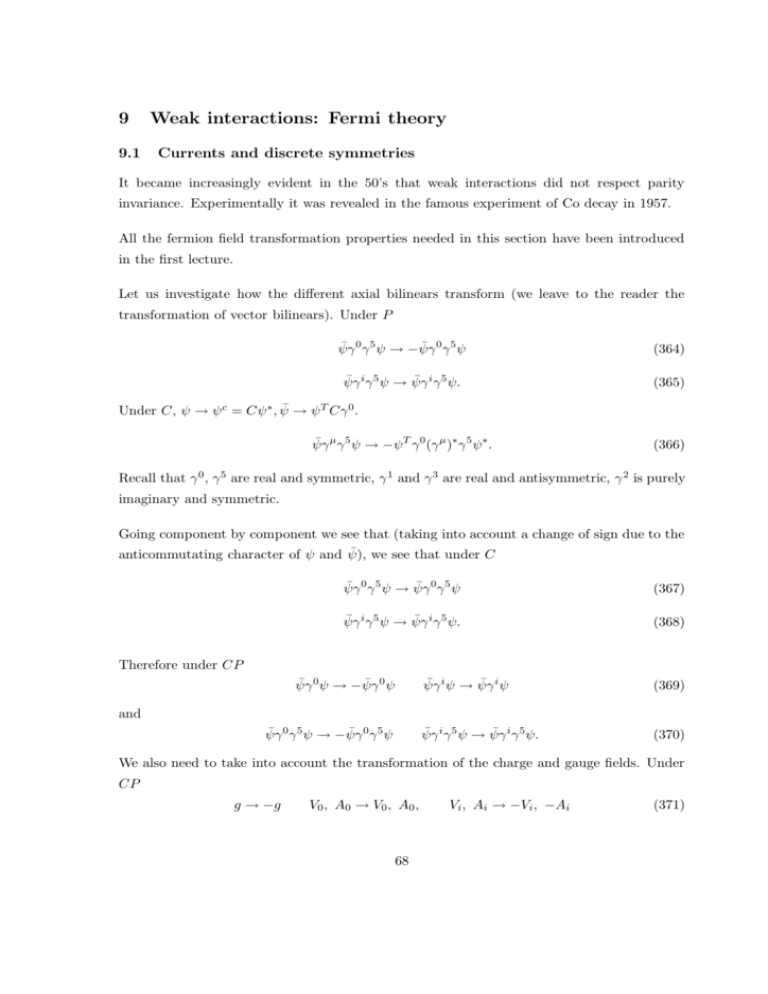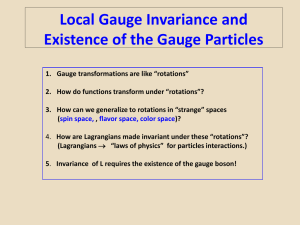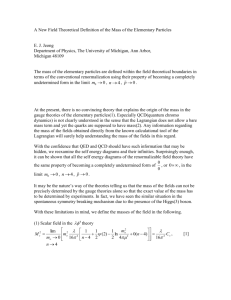Fermi theory
advertisement

9 9.1 Weak interactions: Fermi theory Currents and discrete symmetries It became increasingly evident in the 50’s that weak interactions did not respect parity invariance. Experimentally it was revealed in the famous experiment of Co decay in 1957. All the fermion field transformation properties needed in this section have been introduced in the first lecture. Let us investigate how the different axial bilinears transform (we leave to the reader the transformation of vector bilinears). Under P ψ̄γ 0 γ 5 ψ → −ψ̄γ 0 γ 5 ψ (364) ψ̄γ i γ 5 ψ → ψ̄γ i γ 5 ψ. (365) Under C, ψ → ψ c = Cψ ∗ , ψ̄ → ψ T Cγ 0 . ψ̄γ µ γ 5 ψ → −ψ T γ 0 (γ µ )∗ γ 5 ψ ∗ . (366) Recall that γ 0 , γ 5 are real and symmetric, γ 1 and γ 3 are real and antisymmetric, γ 2 is purely imaginary and symmetric. Going component by component we see that (taking into account a change of sign due to the anticommutating character of ψ and ψ̄), we see that under C ψ̄γ 0 γ 5 ψ → ψ̄γ 0 γ 5 ψ (367) ψ̄γ i γ 5 ψ → ψ̄γ i γ 5 ψ. (368) Therefore under CP ψ̄γ 0 ψ → −ψ̄γ 0 ψ ψ̄γ i ψ → ψ̄γ i ψ (369) ψ̄γ i γ 5 ψ → ψ̄γ i γ 5 ψ. (370) and ψ̄γ 0 γ 5 ψ → −ψ̄γ 0 γ 5 ψ We also need to take into account the transformation of the charge and gauge fields. Under CP g → −g V 0 , A0 → V0 , A0 , 68 Vi , Ai → −Vi , −Ai (371) The conclusion is that a term such as gVµ ψ̄γ µ ψ (372) gAµ ψ̄γ µ γ 5 ψ (373) respects C and P , and that violates C and P but respects CP Scalar and pseudoscalar couplings are interesting too. Under parity ψ̄ψ → ψ̄ψ ψ̄γ 5 ψ → −ψ̄γ 5 ψ. (374) ψ̄γ 5 ψ → ψ̄γ 5 ψ. (375) Under C ψ̄ψ → ψ̄ψ Therefore if in the lagrangian we have terms of the form Φψ̄ψ, χψ̄γ 5 ψ, (376) χ → −χ (377) and we want to preserve CP invariance Φ → Φ, Furthermore, hermiticity requires the coupling to be real in the first case and imaginary in the other λΦψ̄ψ iηχψ̄γ 5 ψ (378) If χ cannot change under the transformation because it takes a non-zero vacuum expectation value φ = φ0 + Z d3 p (ap e−ipx + a† eipx ), (2π)3 2E φ0 = h0|φ|0i, (379) then we have CP violation. This turns out to be the situation in the standard model. 9.2 Fermi Theory We begin our discussion by considering the simplest process involving the β desintegration of the negatively charged muon µ− → e− νµ ν̄e (380) Phenomenologically several things are clear: (1) the interaction takes place at very short distances; it can be consider point-like as a first approximation. (2) Only left-handed neutrinos (or right-handed antineutrinos) are produced and interact in nature, so only left handed 69 components should be involved. (3) The interaction has a constant strength with energy, so no derivatives must be involved. (4) The interaction preserves chirality. Not all these properties can be derived from the muon decay, of course, they are rather inferred from studying a series of weak processes. Let us review the above points one by one. (1) suggests that if weak interactions are mediated by some particle this must be very heavy. In fact the intermediate bosons that are the carriers of weak interactions W ± and Z have all masses in the vicinity of 100 GeV, leading to an effective range of the integration of the order of 10 −2 fm, or less. Point (4) indicates that the currents coupling to these intermediate bosons must be either vector-like or axial-vectorlike, as scalar and pseudoscalar currents do not preserve chirality. Point (2) indicates that these currents are of the form V − A, i.e. ψ̄γ µ (1 − γ5 )ψ. Any other combination of V and A currents would lead to the production of right-handed neutrinos. They have never been observed. Finally, point (3) is again compatible with the existence of some heavy intermediate vector bosons (they must be vectors, particles of spin one, as they mut couple to the V − A current in a Loretz invariant way. Indeed if one considers a fermion-antifermion coupling to a ’heavy photon’, one would be led (using the Feynman rules) to the following four-fermion term ∼ g 2 v̄γ µ u At low energy this reduces to k2 1 ūγµ v. − M 2 + i (381) g2 v̄γ µ uūγµ v. (382) M2 The ’effective’ four-fermion coupling is indeed approximately constant. Furthermore since ∼− only left handed neutrinos exist, and chirality is conserved we can introduce (1 − γ 5 ) factors ∼− g2 v̄γ µ (1 − γ 5 )uūγµ (1 − γ 5 )v. 4M 2 (383) The simplest model accounting by all those features describing the muon beta decay has as a lagrangian GF L = √ ν̄µ γ α (1 − γ 5 )µēγα (1 − γ 5 )νe (384) 2 Recall that the electron field creates positrons and annihilates electrons, the neutrino fiel creates antineutrinos and annihilates neutrinos, etc. Similar processes exist for the τ decay both into muons and into electrons. A comprehensive description is provided by the following lagrangian GF L = √ J µ Jµ† 2 70 (385) where J µ = ν̄e γ µ (1 − γ 5 )e + ν̄µ γ µ (1 − γ 5 )µ + ν̄τ γ µ (1 − γ 5 )τ (386) This is Fermi theory. At this point we need not make any reference to the intermediate vector bosons. The value of the Fermi constant is G F = 1.16637(1) × 10−5 GeV−2 . Note that since in the Dirac representation (that we shall use here) Cγ 5 = −γ 5 C, charge conjugation does change left handed into right handed fields and vice-versa. This implies that weak interactions that have a V − A structure do not respect charge conjugation either. On the contrary, QED is separately invariant under C and P Unfortunately, elementary power counting shows that Fermi theory does not make sense at higher orders in perturbation theory. Each order in perturbation theory is more and more divergent and there is no way to absorb these divergences. Long ago it was recognized that only gauge theories could provide interesting renormalizable theories. So the obvious way out is to reinstate intermediate vector bosons, playing a role similar to the photon. At high energies, that are the ones leading to trouble in the higher order loop integrals, the intermediate boson propagators cannot be treated as a constant! This changes the ultraviolet behaviour completely. This amounts to introducing an interaction term that looks like g − √ ν̄µ γ µ (1 − γ 5 )Wµ+ µ + h.c 2 2 (387) as well as similar terms for the electron and the tau. The overall constant in front is so far arbitrary. We include the ‘+’ index in the intermediate boson field W to indicate that (on account of charge conservation) it must be positively charged. We can go one step further and introduce the following doublets νe e ! , L νµ µ ! ντ , τ L ! . Then the previous interaction term can be written as √ ! ! 0 2 νµ µ1 Wµ+ −g(ν̄µ µ̄)L γ 2 0 0 µ L or −g(ν̄µ µ̄)L γ µτ − 2 71 Wµ+ νµ µ ! , L (388) L (389) (390) with 1 τ − = √ (τ 1 + iτ 2 ), 2 The hermitian conjugated term will be −g(ν̄µ µ̄)L γ 1 W + = √ (W 1 − iW 2 ). 2 µτ + 2 Wµ− νµ µ ! , (391) (392) L where Wµ− = (Wµ+ )+ . These terms would be exactly those that would appear in the lagrangian should a minimal coupling term of the form ~τ ~ 6 D ≡ γ µ (∂µ + ig W µ) 2 (393) exist; similar to QED. Then the ensuing Lagrangian would have a local gauge symmetry under the group SU (2). Since this acts only on left-handed fields, the groups is called SU (2)L . Under this group ψL = l l0 ! (394) L transforms as ψL → ψL0 = ΩψL , (395) Dµ → Ω† Dµ Ω, (396) and where Ω is a matrix of SU (2)L . This would imply the existence of a neutral J µ3 current, associated to the third generator τ 3 , needed to keep the gauge structure and gauge symmetry, that turns out to be essential to prove renormalizabity, i.e. theoretical contron over higher order corrections. The existence of such neutral interactions was proved in 1973 at CERN in experiments of neutrino scattering. However, unlike in QED (or QCD for that matter) these intermediate vector bosons cannot be massless because that would imply that weak interactions are either long range or confining, which is not the case. For additional reading see: http://www.cerncourier.com/main/article/38/8/15 The coupling to fermions would be given by the following piece in the lagrangian iψ̄L 6 DψL , 72 (397) where ψL would correspond to any of the three doublets, or i X f ψ̄Lf 6 DψLf , (398) Again, this corresponds to a local gauge invariance based on the group SU (2) L ; we remark that it only acts on left-handed fields. Right handed fields do not have genuine weak interactions! In 1954 Yang and Mills had actually introduced the concept of local gauge invariance, precisely using the SU (2) group in an attempt to formulate a theory of hadron dynamics. As a result, a triplet of self interacting gauge bosons emerged. Unfortunately these mesons were massless and the theory could not describe weak interactions. It could not describe hadron dynamics either because colour was not introduced and the gauge group was basen on isospin, like the Fermi theory. 9.3 The muon mean life Let us first of all review the Feynman rules, that are actually quite easy to guess. They are identical to the ones of QED, except that we must √F for any four-fermion vertex. (1) Include i G 2 (2) Write γ µ (1 − γ5 ) every time one would write γ µ in a QED vertex. Note also that (v̄γ µ (1 − γ5 )u)∗ = ūγ µ (1 − γ5 )v. Let us now comoute the matrix element relevant for µ-decay. The process is µ− (p) → e− (q1 )ν̄e (q2 )νµ (q3 ). (399) Applying the Feynman rules we get GF iM = i √ v̄(q3 )γ µ (1 − γ 5 )u(p)ū(q1 )γµ (1 − γ 5 )v(q2 ). 2 (400) and, neglecting neutrino masses, XX i f |M |2 = GF T r((1 − γ 5 ) 6 pγ α 6 q3 γ µ )T r((1 − γ 5 ) 6 q2 γα 6 q1 γµ ). 4 73 (401) The new element in the calculation is the appeareance of traces with γ 5 . Using the results of lecture 1, and ρασµ τ ανµ = 2(δτρ δνσ − δνρ δτσ ), (402) it is immediate to get XX i f |M |2 = 16G2F (pq1 )(q2 q3 ) (403) All is left is to evaluate the phase space. The final result is Γ= G2 m5µ 1 8m2 = F 3 (1 − 2e ). τµ 192π mµ (404) The muon life-time is 2.19712(8) × 10 −6 s. 9.4 Weak interactions of quarks. Cabibbo angle It is quite natural to extend weak interactions to quarks. They can also be grouped in doublets u d ! c s L ! t L b ! . (405) L We note that the upper member of the doublet has a charge greater that the lower one by one unit. It is thus exactly the same structure as for leptons, so we can write more or less immediately a charged weak current in terms of quarks J µ = ūγ µ (1 − γ 5 )d + c̄γ µ (1 − γ 5 )s + t̄γ µ (1 − γ 5 )b. (406) The total weak current consists of the one constructed with leptons and the above one, made with quarks. The Fermi lagrangian, of the current × current type then gives all possible crossed terms. The fact that the structure and coefficients are the same for all three generations (for quarks too!) is called ’universality’ of the weak interactions and it is rather well tested by now. The above expression of the quark weak current is not final however. The reason is the following. The lagrangian (398) needs to be complemented with a mass term for the different fermions. If we neglect neutrino masses we shall have for the leptons the term (i, j are family indices) − X l̄i Mij lj ij 74 (407) In principle, hermiticity requirements force M to be hermitian, but not diagonal, but of course it can be diagonalized by redefining the fields l. It can be checked that this has no consequences on the Fermi lagrangian, since we can rotate in a compensating way the neutrino fields, that do not have a mass matrix, and absorb the change. For quarks the situation is slightly more complicated. We can have two such mass matrices rather than one (in fact since we know for sure since 1998 that neutrinos have masses the same situation happens there, but the effects are for ordinary particle physics experiment very small). Let us write − X ij q¯u i Miju quj − X q¯d i Mijd qdj . (408) ij One of the matrices refers to quarks type up (charge 2/3) and the other one to quarks type down (charge -1/3). Since they have different charges superselection rules make mixing of both types impossible. We can easily diagonalize both M u and M d since they are again hermitian, and introduce in this way new fields qui and qdj that are the ones that diagonalize the mass matrices. But then this diagonalization procedure leaves a trace in the quark weak current! The reason is that the diagonalization matrices are different for up-type and down-type. The most general quark current is then (we write it for two generations only) J µ = ūγ µ (1 − γ 5 )(cos θc d + sin θc s) + c̄γ µ (1 − γ 5 )(cos θc s − sin θc d). (409) The angle θc is called the Cabibbo angle. Are the mass terms compatible with SU (2) gauge symmetry? This is not obvious since the upper and lower component of the doublets are treated differently. In fact, as presented, they are not! To fix this problem requires the introduction of a new particle, a new degree of freedom, the so-called Higgs particle. A detailed treatment of this problem goes beyond the scope of these notes, but the general ideas will be presented in lecture 11 in a different context and the specif couplings and lagrangian will be presentented in lecture 10. 75






